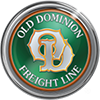The Top Advantages of Electronic Bill of Ladings: Boost Your Freight Efficiency
For shippers exploring digital solutions, transitioning to an electronic bill of lading (eBOL) is an excellent starting point. An eBOL captures all the essential information about a shipment’s origin, destination, contents, and more.
This digitalization shift is part of a broader industry trend to modernize processes that have traditionally been physical documents, such as delivery receipts, or replacing traditional paper BOLs with solutions such as electronic bill of lading tools. And that’s good for supply chains. The earlier that information is digitized, the more accurate and readily available it will be throughout your supply chain.
Wondering if it’s worth the switch to electronic bills of lading? Here are the key advantages of using a digital bill of lading and how it enhances freight management.
Increase Efficiency
When customers send an eBOL before our team at Old Dominion Freight Line picks up the freight, we can begin load planning immediately. This allows us to proactively maximize the inside of the trailer based on future shipment information instead of relying on our best guess with historical data. This streamlined operational approach helps us keep your rates lower by decreasing your transit times and maximizing line haul efficiency. Using eBOLs also helps with the billing process, as bills and payments can be generated quicker than paper invoices, translating into faster payments from your customers.
Minimize Errors
When you use electronic BOLs, there’s less risk for entering incorrect information. Traditional paper BOLs can lead to manual data entry errors, which can disrupt your shipping process. After all, BOL errors impact everything in the shipment process from that point forward. By using a digital bill of lading solution, information transfer to your carrier is seamless as everything is passed on electronically, not by individuals writing on or transferring information from paper.
The eBOL system makes it easy and simple to setup pickups. We can track and retrieve invoices without making a phone call and save the consignee and description of goods.
More tracking visibility
Visibility is crucial for effective digital freight management. We know you want detailed information about your shipments’ movements in real-time. When you use eBOLs, it’s easier for reference numbers to be seamlessly integrated into our tracking systems and give a full picture of a shipment’s status. Our customers can then access enhanced data about their shipment to make their own estimated time of arrival and status updates. This streamlined process gives you greater control over shipment visibility. To see how technology is transforming freight services and how Old Dominion is leading the way, read our whitepaper, “Managing Complexity in a Changing World.”
Electronic Proof of Delivery
Paper documents like traditional BOLs and proof of delivery receipts may pass through several in-person interactions. Using eBOLs not only minimizes physical contact and speeds up the shipping process, but it also offers electronic proof of delivery receipt. Less contact, more efficiency. It’s a win-win situation.
I love the eBOL and it’s great that I can save customers’ names and addresses. It’s super easy to transition to scheduling pickups.
Getting Started with eBOLs
To reap the benefits of electronic bill of ladings, the first step is to set up an account with your carrier. As an Old Dominion customer, you can easily create eBOL documents and schedule pickups with established pricing and an ODFL.com account. Adopting digital BOLs enables you to decrease errors, improve communication with your carrier, and improve your shipping workflow. This simplifies your freight management process and also positions your business to adapt to the digital future of shipping.
Interested in a more advanced solution? Our team works with companies of any size to seamlessly transmit eBOL data into your own systems, without needing to use ODFL.com. Additionally, our API is compatible with NMFTA’s industry standard. Contact us to get started.

